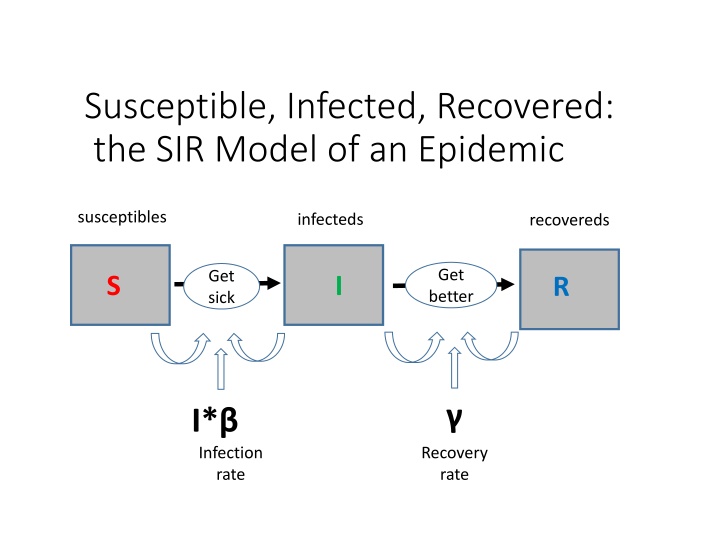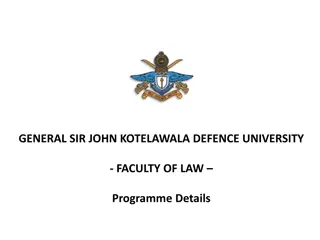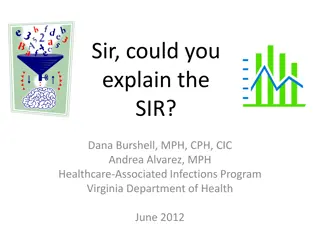
The SIR Epidemic Model for Disease Spread
Explore the SIR model of epidemics, focusing on susceptibles, infecteds, and recovereds. Learn how mathematical models help predict disease dynamics and control strategies to combat infectious diseases.
Download Presentation

Please find below an Image/Link to download the presentation.
The content on the website is provided AS IS for your information and personal use only. It may not be sold, licensed, or shared on other websites without obtaining consent from the author. If you encounter any issues during the download, it is possible that the publisher has removed the file from their server.
You are allowed to download the files provided on this website for personal or commercial use, subject to the condition that they are used lawfully. All files are the property of their respective owners.
The content on the website is provided AS IS for your information and personal use only. It may not be sold, licensed, or shared on other websites without obtaining consent from the author.
E N D
Presentation Transcript
Susceptible, Infected, Recovered: the SIR Model of an Epidemic susceptibles infecteds recovereds Get better Get sick S I R I* Infection rate Recovery rate
What is a Mathematical Model? a mathematical description of the real-world focuses on specific quantitative features of the scenario, ignores others (simplification) involves hypotheses that can be tested against real data
Why Study Epidemic Models? To supplement statistical extrapolation. To learn more about the qualitative dynamics of a disease. To test hypotheses about, for example, prevention strategies, disease transmission, significant characteristics, etc.
Why SIR models? Infectious diseases kill millions of people world-wide Malaria, TB, HIV/AIDS New diseases emerge suddenly and spread quickly SARS, West Nile Virus, HIV, Avian Influenza Effective and fast control measures are needed Models allow you to predict (estimate) when you don t KNOW What are the costs and benefits of different control strategies? When should there be quarantines? Who should receive vaccinations? When should wildlife or domestic animals be killed? Which human populations are most vulnerable? How many people are likely to be infected? To get sick? To die?
The SIR Epidemic Model Consider a disease spread by contact with infected individuals. Individuals recover from the disease and gain further immunity from it. S = fraction of susceptibles in a population I = fraction of infecteds in a population R = fraction of recovereds in a population S + I + R = 1
Simple SIR Model Susceptibles (S) have no immunity from the disease. Infecteds (I) have the disease and can spread it to others. Recovereds (R) have recovered from the disease and are immune to further infection. Kermack & McKendrick, 1927
Parameters of the Model I*beta= the infection rate gamma= the removal rate The basic reproduction number is obtained from these parameters: NR = infection rate / removal rate This number represents the average number of infections caused by one infective in a totally susceptible population. As such, an epidemic can occur only if NR > 1.
Vaccination and Herd Immunity If only a fraction S0 of the population is susceptible, the reproduction number is NRS0, and an epidemic can occur only if this number exceeds 1. Suppose a fraction V of the population is vaccinated against the disease. In this case, S0=1-V and no epidemic can occur if V > 1 1/NR The basic reproduction numberNR can vary from 3 to 5 for smallpox, 16 to 18 for measles, and over 100 for malaria [Keeling, 2001].
What if R isnt realisitic? Susceptibles (S) have no immunity from the disease. Infecteds (I) have the disease and can spread it to others. susceptibles infecteds If there is no immunity after being sick, individuals cycle between S and I. What do we then need to add to the model? Get sick S I I* Infection rate
Enhancing the SIR Model Can consider additional populations of disease vectors (e.g. fleas, rats). Can consider an exposed (but not yet infected) class, the SEIR model. SIRS, SIS, and double (gendered) models are sometimes used for sexually transmitted diseases. Can consider biased mixing, age differences, multiple types of transmission, geographic spread, etc. Enhancements often require more compartments.
The effect of the airline transportation network Main modeling features (SARS, H1N1, etc.): SIR model with empirical population and airline traffic/network data homogeneous mixing within cites network connections and stochastic transport between cities Colizza et al. (2007) PLoS Medicine 4, 0095
H1N1 Flu http://www.gleamviz.org/ Mobility networks in Europe (network-coupled SIR model): Left: airport network; Right: commuting network.
H1N1 Flu http://www.gleamviz.org/ http://www.gleamviz.org/2009/09/us-early-outbreak-real-vs-simulated-geographic-pattern/ http://www.gleamviz.org/2009/09/us-winter-projections-mitigation-effect-of-antiviral-treatment/
Todays Agenda Work with Stamps Flu Data Examine the data going into the model Think: What can it capture? What s it leaving out? Run statistical models in R Get practice thinking about what each of your variables means biologically, and what you can (and cannot say) using them Start basic coding of stats and graphs from which to draw conclusions of biological relevance Think: What variables am I using, and why? Do my graphs tell the same story as my stats? What do I get by using both? Work with Stamps Norovirus Data Examine the data going into the model Again, Think: What can it capture? What s it leaving out? Run Spatial Analysis Get practice using spatial tools, and think about how this information can inform SIR models Practice cleaning up data for more complex analysis, and argue for proposed health interventions based on your evidence (data and models) Think: What data is most important here? How does the prognosis improve, based on my models, if I were to change a certain parameter through a specific intervention?
References J. D. Murray, Mathematical Biology, Springer-Verlag, 1989. O. Diekmann & A. P. Heesterbeek, Mathematical Epidemiology of Infectious Diseases, Wiley, 2000. Matt Keeling, The Mathematics of Diseases, http://plus.maths.org, 2004. Allyn Jackson, Modeling the Aids Epidemic, Notices of the American Mathematical Society, 36:981-983, 1989.






















